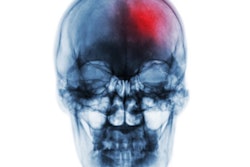
Patients with suspected large vessel occlusion (LVO) stroke can have better long-term outcomes if they are transferred directly to the angiography suite for diagnosis upon admission, according to research published online August 2 in JAMA Neurology.
A team, led by researchers from the Hospital Universitari Vall d'Hebron in Barcelona, Spain, evaluated the outcomes of 174 suspected LVO stroke patients who had been assessed using either conventional neuroimaging protocols -- CT and CT angiography (CTA) -- or in the angiography suite with flat-panel CT and an angiogram. They found that adults with ischemic stroke due to LVO had better long-term outcomes from a direct-to-angiography suite protocol that bypasses the emergency department and conventional imaging.
"For patients with LVO admitted within six hours after symptom onset, this randomized clinical trial found that, compared with conventional workflow, the use of [the direct-to-angiography suite protocol] decreased hospital workflow time, and improved clinical outcome," wrote a group led by first author Manuel Requena, PhD, and corresponding author Dr. Marc Ribo, PhD.
Although a protocol of transferring patients with clinically suspected LVO directly to the angiography suite has been shown to be a safe and effective means of reducing time to endovascular treatment, the researchers sought to determine if these patients had more favorable long-term clinical outcomes compared with those patients who received conventional neuroimaging.
They randomly assigned 174 suspected LVO acute stroke patients to receive either the direct-to-angiography suite protocol (89 patients) or conventional neuroimaging with CT and CTA (85 patients). The patients had a mean stroke symptom onset-to-door time of 228 minutes and a median U.S. National Institutes of Health (NIH) Stroke Scale Score of 18 at admission. Patient outcome was assessed at 90 days using the modified Rankin scale.
Of those patients who were diagnosed with LVO stroke and were to receive treatment, endovascular treatment was performed in all 74 patients in the direct-to-angiography group and in 64 (87.7%) of the conventional workflow group. That difference was statistically significant (p = 0.02). The direct-to-angiography group also received endovascular treatment sooner.
| Improved workflow from direct-to-angiography suite protocol for LVO stroke | ||
| Conventional neuroimaging protocol (CT and CTA) | Direct-to-angiography suite protocol (flat-panel CT and angiography) | |
| Median door-to-arterial puncture time | 42 minutes | 18 minutes |
| Median door-to-reperfusion time | 84 minutes | 57 minutes |
Importantly, the direct-to-angiography suite protocol yielded an adjusted common odds ratio of 2.2, for a 1-point improvement on the modified Rankin scale (p = 0.009).
The researchers also reported that safety variables were comparable between the two patient groups. Ongoing multicenter clinical trials are now exploring the generalizability of these results, according to the researchers.
"To offer the clinical benefits of [the direct-to-angiography suite protocol] to the highest number of patients, the angiography suite and interventional team should be immediately available 24 hours a day, seven days a week," the authors noted. "Having a dedicated acute stroke angiography suite and permanently available team would require organizational and staff efforts that would be justified in large volume centers if our results are confirmed in a second randomized clinical trial."



















